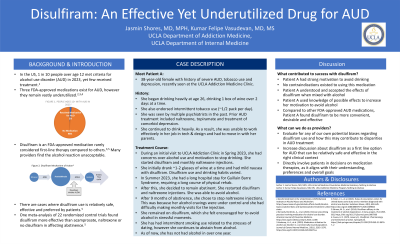Back

(133) Disulfiram: An Effective Yet Underutilized Drug for AUD
Saturday, April 26, 2025
9:45 AM – 1:15 PM
Location: Aurora Ballroom Pre-Function, Level 2


Jasmin Shores, MD, MPH
Internal Medicine - Preventative Medicine Resident
UCLA, California- KV
Kumar Felipe Vasudevan, MD
Attending Physician
UCLA, California
Presenter(s)
Non-presenting author(s)
Background & Introduction: Within the US around 2023, 1 in 10 people over age 12 met criteria for alcohol use disorder (AUD), but only 2% received medication treatment.1 Three FDA-approved medications exist for AUD, disulfiram being the oldest. Disulfiram is an aldehyde dehydrogenase inhibitor causing nausea and vomiting when mixed with alcohol.2 It is contraindicated in some conditions including cirrhosis, severe coronary artery disease and psychosis.2 Otherwise, disulfiram is relatively safe and inexpensive, but rarely considered first line therapy.3 Many providers avoid prescribing disulfiram because they find the alcohol reaction unacceptable. In the LA area, there have also been drug shortages, likely from underprescription.7 One study of ~20,000 patients with AUD showed about 17% were prescribed disulfiram as an initial medication (vs. 42% prescribed oral naltrexone and 22% prescribed acamprosate).5 There are many instances where patients prefer disulfiram and when taken appropriately, it can be effective. One meta-analysis comparing 22 randomized control trials found disulfiram more effective than acamprosate, naltrexone or no disulfiram in affecting abstinence (g=0.58, 95%CI = .35–.82).3 The following case provides an example, amongst many others, of disulfiram efficacy in efforts to encourage providers to increase utilization of disulfiram as another tool to help patients with AUD.
Case Description: This case focuses on an adult female patient seen in the UCLA Addiction Medicine Clinic over the last several years. The patient is a 38-year-old with a significant medical history of severe AUD, tobacco use and major depressive disorder. She first began drinking heavily at age 26, drinking up to 1 box of wine over the course of two days. She also endorsed intermittent tobacco use (~1/2 pack per day). She had seen multiple psychiatrists in the past, with prior AUD treatment regimen including naltrexone, topiramate and psychiatric care of comorbid mood disorder. However, she continued to drink heavily. As a result, she could no longer work effectively in her job in tech & design and was forced to move in with her parents. During her initial visit to UCLA Addiction Clinic in Spring 2023, she expressed concern over her alcohol use and high motivation to stop drinking. She was started on disulfiram 250mg daily, in addition to monthly naltrexone injections. Initially, she drank about 1-2 glasses of wine at a time and experienced mild nausea with disulfiram. She intermittently stopped and restarted disulfiram, and her drinking habits varied significantly. Around Summer 2023, she was hospitalized for Guillain Barre Syndrome for several weeks, then required a long course of physical rehab. After this experience, she decided to remain fully abstinent. She restarted disulfiram and naltrexone injections and was able to avoid alcohol. She also slowly re-entered the workforce. After being sober for 9 months, she decided to stop naltrexone injections. This was related to feeling her alcohol cravings were under control and having difficulty arranging for monthly injection visits with her work schedule. She chose to remain on disulfiram, because she wished to avoid the undesirable effect of nausea when drinking alcohol and she felt this would encourage her to avoid alcohol in stressful moments. She was successful in continued sobriety and has expressed feelings of pride for how far she has come. Although she has had ongoing intermittent smoking use related to stresses of dating, she continues to abstain from alcohol. As of now she has not had an alcoholic beverage in over one year.
Conclusion & Discussion: This case report highlights the effectiveness of disulfiram in the right clinical context. In this patient’s case, factors that allowed disulfiram to be effective included her ability to adhere to a daily medication, understand and accept the side effects it has when mixed with alcohol and demonstrate motivation to avoid these side effects. She used the negative implications of mixing alcohol with disulfiram to enhance her motivation towards sobriety. Other FDA-medication options were discussed and she tried naltrexone injections with some effect. However ultimately, these other medications were not effective, convenient or desirable. There is concern that conversations about disulfiram are not happening often with patients, and this is occurring to their detriment. This case emphasizes that in patients who are generally healthy without contraindications to disulfiram use and with interest in this medication, disulfiram can be safe and highly effective. Disulfiram should be reconsidered as a first line agent for AUD, and we as providers must evaluate for potential biases we may have regarding this. It is also vital that patients remain directly engaged in consideration of medication therapy, given they are best able to share their understanding, preferences and needs as they relate to their treatment plan.
References: 1. Alcohol treatment in the United States. (2025) National Institute on Alcohol Abuse and Alcoholism. https://www.niaaa.nih.gov/alcohols-effects-health/alcohol-topics-z/alcohol-facts-and-statistics/alcohol-treatment-united-states
2. Holt, S. (2024). Alcohol use disorder: Pharmacologic management. UpToDate. https://www.uptodate.com/contents/alcohol-use-disorder-pharmacologic-management?search=alcohol+use+disorder+management&source=search_result&selectedTitle=1~150&usage_type=default&display_rank=1#H3062046966
3. Skinner, M. D., Lahmek, P., Pham, H., & Aubin, H.-J. (2014). Disulfiram efficacy in the treatment of alcohol dependence: A meta-analysis. PLoS ONE, 9(2). https://doi.org/10.1371/journal.pone.0087366
4. Kennedy-Hendricks, A., Busch, A. B., Azeni, H., Horgan, C. M., Uscher-Pines, L., Hodgkin, D., & Huskamp, H. A. (2024). Clinician prescribing practices involving medications for alcohol use disorder. American Journal of Preventive Medicine. https://doi.org/10.1016/j.amepre.2024.11.006
5. Huskamp, H. A., Reif, S., Greenfield, S. F., Normand, S.-L. T., & Busch, A. B. (2020). Medication utilization for alcohol use disorder in a commercially insured population. Journal of General Internal Medicine, 35(11), 3262–3270. https://doi.org/10.1007/s11606-020-06073-w
Case Description: This case focuses on an adult female patient seen in the UCLA Addiction Medicine Clinic over the last several years. The patient is a 38-year-old with a significant medical history of severe AUD, tobacco use and major depressive disorder. She first began drinking heavily at age 26, drinking up to 1 box of wine over the course of two days. She also endorsed intermittent tobacco use (~1/2 pack per day). She had seen multiple psychiatrists in the past, with prior AUD treatment regimen including naltrexone, topiramate and psychiatric care of comorbid mood disorder. However, she continued to drink heavily. As a result, she could no longer work effectively in her job in tech & design and was forced to move in with her parents. During her initial visit to UCLA Addiction Clinic in Spring 2023, she expressed concern over her alcohol use and high motivation to stop drinking. She was started on disulfiram 250mg daily, in addition to monthly naltrexone injections. Initially, she drank about 1-2 glasses of wine at a time and experienced mild nausea with disulfiram. She intermittently stopped and restarted disulfiram, and her drinking habits varied significantly. Around Summer 2023, she was hospitalized for Guillain Barre Syndrome for several weeks, then required a long course of physical rehab. After this experience, she decided to remain fully abstinent. She restarted disulfiram and naltrexone injections and was able to avoid alcohol. She also slowly re-entered the workforce. After being sober for 9 months, she decided to stop naltrexone injections. This was related to feeling her alcohol cravings were under control and having difficulty arranging for monthly injection visits with her work schedule. She chose to remain on disulfiram, because she wished to avoid the undesirable effect of nausea when drinking alcohol and she felt this would encourage her to avoid alcohol in stressful moments. She was successful in continued sobriety and has expressed feelings of pride for how far she has come. Although she has had ongoing intermittent smoking use related to stresses of dating, she continues to abstain from alcohol. As of now she has not had an alcoholic beverage in over one year.
Conclusion & Discussion: This case report highlights the effectiveness of disulfiram in the right clinical context. In this patient’s case, factors that allowed disulfiram to be effective included her ability to adhere to a daily medication, understand and accept the side effects it has when mixed with alcohol and demonstrate motivation to avoid these side effects. She used the negative implications of mixing alcohol with disulfiram to enhance her motivation towards sobriety. Other FDA-medication options were discussed and she tried naltrexone injections with some effect. However ultimately, these other medications were not effective, convenient or desirable. There is concern that conversations about disulfiram are not happening often with patients, and this is occurring to their detriment. This case emphasizes that in patients who are generally healthy without contraindications to disulfiram use and with interest in this medication, disulfiram can be safe and highly effective. Disulfiram should be reconsidered as a first line agent for AUD, and we as providers must evaluate for potential biases we may have regarding this. It is also vital that patients remain directly engaged in consideration of medication therapy, given they are best able to share their understanding, preferences and needs as they relate to their treatment plan.
References: 1. Alcohol treatment in the United States. (2025) National Institute on Alcohol Abuse and Alcoholism. https://www.niaaa.nih.gov/alcohols-effects-health/alcohol-topics-z/alcohol-facts-and-statistics/alcohol-treatment-united-states
2. Holt, S. (2024). Alcohol use disorder: Pharmacologic management. UpToDate. https://www.uptodate.com/contents/alcohol-use-disorder-pharmacologic-management?search=alcohol+use+disorder+management&source=search_result&selectedTitle=1~150&usage_type=default&display_rank=1#H3062046966
3. Skinner, M. D., Lahmek, P., Pham, H., & Aubin, H.-J. (2014). Disulfiram efficacy in the treatment of alcohol dependence: A meta-analysis. PLoS ONE, 9(2). https://doi.org/10.1371/journal.pone.0087366
4. Kennedy-Hendricks, A., Busch, A. B., Azeni, H., Horgan, C. M., Uscher-Pines, L., Hodgkin, D., & Huskamp, H. A. (2024). Clinician prescribing practices involving medications for alcohol use disorder. American Journal of Preventive Medicine. https://doi.org/10.1016/j.amepre.2024.11.006
5. Huskamp, H. A., Reif, S., Greenfield, S. F., Normand, S.-L. T., & Busch, A. B. (2020). Medication utilization for alcohol use disorder in a commercially insured population. Journal of General Internal Medicine, 35(11), 3262–3270. https://doi.org/10.1007/s11606-020-06073-w
Learning Objectives:
- Understand disparities in medication treatment of alcohol use disorder (AUD), more specifically with regard to disulfiram.
- Understand the efficacy of disulfiram for treatment of AUD.
- Apply considerations of disulfiram use when counseling and treating patients with AUD.
